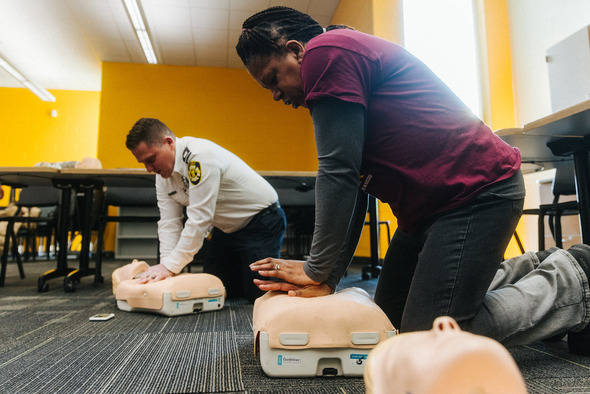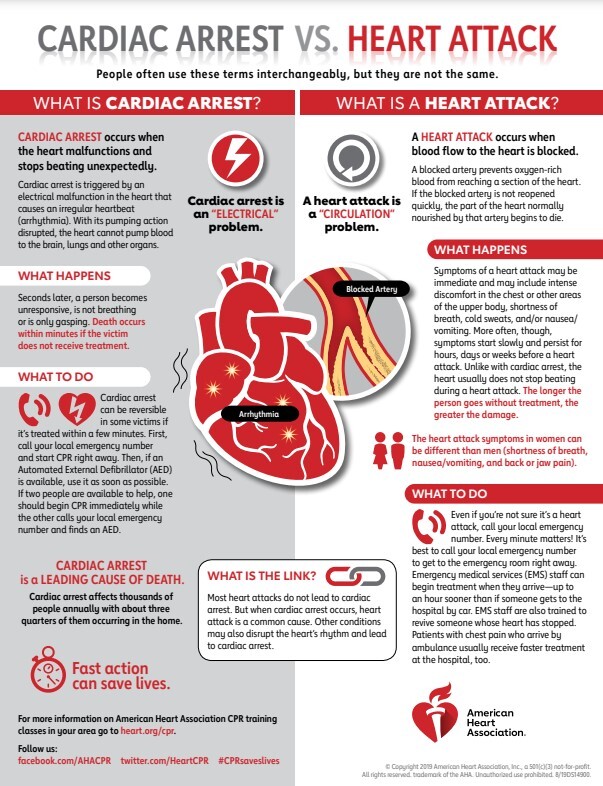Know your heart facts this Valentine’s Day! DFD Educates Public on the Difference Between Heart Attack and Cardiac Arrest
The Detroit Fire Department (DFD) is raising awareness about the critical differences between a heart attack and cardiac arrest—two serious medical emergencies that require quick action but are often confused.
“A heart attack and cardiac arrest are not the same thing, and knowing the difference can save lives,” said Detroit Executive Fire Commissioner Chuck Simms. “Our emergency responders see firsthand the impact of quick action, whether it’s recognizing the warning signs of a heart attack or starting CPR when someone goes into cardiac arrest. We want the people of Detroit to be prepared.”
A heart attack occurs when blood flow to part of the heart is blocked, usually by a clot or narrowed arteries. While the heart is still beating, the affected muscle may suffer permanent damage. Symptoms can develop gradually and include chest pain, shortness of breath, nausea, and discomfort in the arms, neck, or jaw. Heart attacks do not cause a person to become unconscious or collapse. Heart attacks can cause vague symptoms particularly in older people. If you have symptoms call 911.
“Think of a heart attack as a plumbing problem and cardiac arrest as an electrical problem,” explained Detroit Fire Department Medical Director Dr. Robert Dunne. "Cardiac arrest happens suddenly when the heart stops beating properly due to an electrical or mechanical malfunction. The person collapses, becomes unresponsive, and stops breathing normally. Without immediate CPR and defibrillation, cardiac arrest is fatal within minutes. Any sudden collapse when a person is unresponsive should be considered a cardiac arrest, especially in young people. Call 911 and start CPR."

Detroit is a HEARTSafe Community
The City of Detroit has been recognized as a HEARTSafe Community, a designation awarded to cities committed to improving survival rates from sudden cardiac arrest. As part of this initiative, the Detroit Fire Department is leading efforts to train residents on hands-only CPR and AED (Automated External Defibrillator) use to ensure that bystanders are prepared to take action in an emergency.
“We are making it a priority to train as many Detroiters as possible in CPR and AED use,” said Simms. “By equipping our community with these lifesaving skills, we can improve survival rates and make Detroit a safer place.”
PulsePoint AED App: Helping Locate Lifesaving Devices
In addition to training efforts, Detroit is actively participating in the PulsePoint AED app, a mobile application that allows users to quickly locate nearby AEDs in an emergency. The app provides a crowdsourced map of publicly accessible AEDs, helping bystanders and first responders find and use these devices when seconds count.
“We want every Detroiter to download the PulsePoint AED app,” said Dr. Dunne. “If someone collapses in cardiac arrest, knowing where the nearest AED is located can make the difference between life and death.”
The Detroit Fire Department encourages residents to:
- Call 911 immediately at the first signs of a heart attack.
- Learn hands-only CPR to help someone in cardiac arrest.
- Use an AED if available—these devices are designed for easy use and can restart the heart in a cardiac arrest situation.
- Download the PulsePoint AED app to help locate AEDs in an emergency.
“The faster someone gets medical help, the better their chances of survival,” Simms added. “If in doubt, call 911. We’re here to help.”
For more information on CPR training, AED locations, and the PulsePoint AED app, visit https://detroitmi.gov/departments/detroit-fire-department/community-cpr.

About the Detroit Fire Department
The Detroit Fire Department is committed to protecting lives and property through fire suppression, emergency medical services, and public education. Our first responders serve with courage, compassion, and professionalism, ensuring the safety of Detroit’s residents every day.